Leaf-Mining Insects - John A. Byers
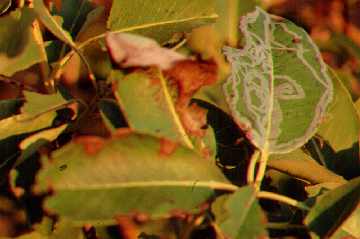 Leaf miners form a natural rather than a taxonomic group of insect species that are
adapted to a special type of environment.
Leaf miners form a natural rather than a taxonomic group of insect species that are
adapted to a special type of environment.
Definition: A leaf miner is a species, the larva of which lives and feeds for a part of all
of its time between the epidermal layers of a leaf. The mining insects have habits that
grade into gall making and deeper plant boring as well as external feeders and
scavengers. There is little difference between a borer and a miner except that the
borer feeds deeper in the tissues of plant. Bark beetles, that mine under the bark in
the phloem and cambium layer could be considered miners or borers. The codling
moth, typically boring in fruit of apples, sometimes mines the surface of the fruit. The
Diptera family of Agromyzidae also show habits of both leaf mining and boring.
Agromyza youngi mines the petioles and flower stalks of dandelion flowers as
well as its leaves. Some leaf-mining species also make galls. Agromyza
laterella (Agromyzidae) produces a gall on a young tender iris leaf but a mine on
mature leaves. In the genus Agromyza, some species like tiliae,
schineri, and websteri are gall makers of citrus, poplar, and wisteria
(respectively), simplex is a stem borer of asparagus, aeniventris and
virens are pith borers, amelanchieris, aceris, and pruinosa
are cambium miners, laterella makes both leaf mines and galls, while most
other species are largely leaf miners of herbaceous and woody plants.
 The family Cecidomyiidae in the order Diptera (flies) have many species that
intergrade between gall making and leaf mining. The tulip spot gall, Thecodipolosis
liriodendri, is only a slight thickening of the leaf while the tar-spot gall, produced
by a species in the genus Asteriomyia has even less thickening is little more
than a leaf mine. The boxwood leaf miner, Monarthropalpus buxi, makes a leaf
mine but the surrounding tissues proliferate. None of the Cecidomyiidae, however,
produce long leaf mines typical of the Agromyzidae flies.
The family Cecidomyiidae in the order Diptera (flies) have many species that
intergrade between gall making and leaf mining. The tulip spot gall, Thecodipolosis
liriodendri, is only a slight thickening of the leaf while the tar-spot gall, produced
by a species in the genus Asteriomyia has even less thickening is little more
than a leaf mine. The boxwood leaf miner, Monarthropalpus buxi, makes a leaf
mine but the surrounding tissues proliferate. None of the Cecidomyiidae, however,
produce long leaf mines typical of the Agromyzidae flies.
Some leaf-surface feeding insects may appear like leaf mines. Some Chironomidae
(Diptera) dig grooves in leaves, removing the upper epidermis and packing the
channels with frass. Many larvae of the order Lepidoptera (moths and butterflies) have
similar habits.
Leaf miners attack nearly all plant families. The insects can mine plants with milky
juices, poisonous to higher animals, and even aquatic plants. Leaf miners are most
numerous in the tropics but are still widely distributed in the temperate zones.
However, miners are rare or nonexistent on high mountain tops or Arctic zones where
plants occur. Insects of four orders have evolved the leaf-mining habit: Coleoptera
(beetles), Lepidoptera (moths), Diptera (flies), and Hymenoptera (sawflies), or in other
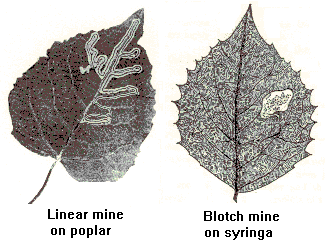 words in orders with complete metamorphosis and the highest degree of
specialization. The adults are able to fly and to select the appropriate host plant for
their larvae. Only the larvae are able to live in the interior of leaves since the adults
are winged and therefore disperse, find host plants, and mate. Most leaf-miner adults
are small and can be very beautifully colored.
words in orders with complete metamorphosis and the highest degree of
specialization. The adults are able to fly and to select the appropriate host plant for
their larvae. Only the larvae are able to live in the interior of leaves since the adults
are winged and therefore disperse, find host plants, and mate. Most leaf-miner adults
are small and can be very beautifully colored.
Coleoptera: In the beetle order, there are 50 North American species, scattered
among three families: Buprestidae, Chrysomelidae, and Curculionidae.
 The Buprestidae are the metallic wood-boring beetles (or flat-headed borers): most
larvae bore under bark or in wood. Adults are metallic copper, green, blue, or black
with hard bodies and can move rapidly with good eyes. The genus Brachys
have species that mine leaves of oak, and these species when disturbed draw up their
legs and "play dead" usually falling to the ground to avoid predation. Other leaf-mining
genera are Trachys and Pachyschelus. These beetles often visit flowers
as adults. The mines of Buprestidae are usually of the blotch type (a cave or irregular
area) but some make wide linear mines. Most mine the leaves of trees and
shrubs, while Taphrocerus mines leaves of sedges and a few species colonize
Leguminosae. Pieces of the leaf may be cut and stuck together with silk. Some
species are quite small, being only a mm or two. Wood boring buprestids can be large
in the tropics such as Euchroma goliath which is 6 cm long (2.5 inches)!
The Buprestidae are the metallic wood-boring beetles (or flat-headed borers): most
larvae bore under bark or in wood. Adults are metallic copper, green, blue, or black
with hard bodies and can move rapidly with good eyes. The genus Brachys
have species that mine leaves of oak, and these species when disturbed draw up their
legs and "play dead" usually falling to the ground to avoid predation. Other leaf-mining
genera are Trachys and Pachyschelus. These beetles often visit flowers
as adults. The mines of Buprestidae are usually of the blotch type (a cave or irregular
area) but some make wide linear mines. Most mine the leaves of trees and
shrubs, while Taphrocerus mines leaves of sedges and a few species colonize
Leguminosae. Pieces of the leaf may be cut and stuck together with silk. Some
species are quite small, being only a mm or two. Wood boring buprestids can be large
in the tropics such as Euchroma goliath which is 6 cm long (2.5 inches)!
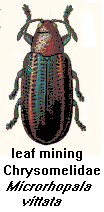 The Chrysomelidae (leaf beetles) is one of the largest families of beetles and includes
the Colorado Potato beetle. These beetles are relatively small (about 1 cm or less)
and often brightly colored. There are many serious pests in this family, and depending
on the species, the larvae feed externally on leaves or roots, bore into the plant, or are
leaf miners. The subfamily Hispinae are leaf-miners, e.g. Xenochalepus dorsalis
on black locust. The genera Chalepus, Microrhopala, Stenispa,
Anoplitis, Baliosis, and Uroplata are also leaf-miners in Hispinae
that are called wedge-shaped beetles. The elytra (wing covers) often are spiny or may
be ridged and sculptured. The larvae are flattened, short legs, and closely resemble
the Chrysomelidae. Another subfamily, Halticinae, has Dibolia borealis which
makes long winding mines on the broad-leaved plantain which may wither the plant.
Hippuriphila modeeri makes blotch mines on leaves of Rumex.
The Chrysomelidae (leaf beetles) is one of the largest families of beetles and includes
the Colorado Potato beetle. These beetles are relatively small (about 1 cm or less)
and often brightly colored. There are many serious pests in this family, and depending
on the species, the larvae feed externally on leaves or roots, bore into the plant, or are
leaf miners. The subfamily Hispinae are leaf-miners, e.g. Xenochalepus dorsalis
on black locust. The genera Chalepus, Microrhopala, Stenispa,
Anoplitis, Baliosis, and Uroplata are also leaf-miners in Hispinae
that are called wedge-shaped beetles. The elytra (wing covers) often are spiny or may
be ridged and sculptured. The larvae are flattened, short legs, and closely resemble
the Chrysomelidae. Another subfamily, Halticinae, has Dibolia borealis which
makes long winding mines on the broad-leaved plantain which may wither the plant.
Hippuriphila modeeri makes blotch mines on leaves of Rumex.

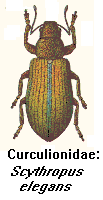 The Curculionidae (weevils or snout beetles) are another large family of beetles with
over 3100 species in North America (and some taxonomists break this family into 11
families). The species have many diverse feeding habits from external feeding to
boring in any plant part, a few even cause galls (Podapion gallicola). The
mandibular mouth parts are small and at the end of a "snout" or "beak" on their head.
Most weevils when disturbed draw their legs and antennae to the body and fall to the
ground. While some are brightly colored, most are cryptic and hard to find. Many can
produce noises by stridulation (rubbing various body parts together to produce sound -
often heard only weakly near the human ear). Another genus is Orchestes,
predominately in Europe, that mine leaves of oaks, alders, and willows. The apple flea
weevil, Orchestes pallicornis may damage fruit in the eastern USA as well as
leaves of elm, willow, shadbush, alder, cherry, and apple. Prionomerus
calceatus mines sassafras and tulip tree leaves. Adults may also feed on the
leaves, making small holes much as do flea beetle adults.
The Curculionidae (weevils or snout beetles) are another large family of beetles with
over 3100 species in North America (and some taxonomists break this family into 11
families). The species have many diverse feeding habits from external feeding to
boring in any plant part, a few even cause galls (Podapion gallicola). The
mandibular mouth parts are small and at the end of a "snout" or "beak" on their head.
Most weevils when disturbed draw their legs and antennae to the body and fall to the
ground. While some are brightly colored, most are cryptic and hard to find. Many can
produce noises by stridulation (rubbing various body parts together to produce sound -
often heard only weakly near the human ear). Another genus is Orchestes,
predominately in Europe, that mine leaves of oaks, alders, and willows. The apple flea
weevil, Orchestes pallicornis may damage fruit in the eastern USA as well as
leaves of elm, willow, shadbush, alder, cherry, and apple. Prionomerus
calceatus mines sassafras and tulip tree leaves. Adults may also feed on the
leaves, making small holes much as do flea beetle adults.
Diptera: In the fly order there are 200 North American species of leaf-miners. The two
families most prominent in this are the Agromyzidae and Anthomyiidae.
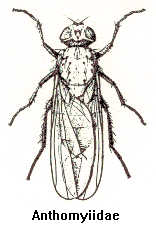 A few species of Tipulidae and Trupaneidae, considerably more Cecidomyiidae (gall makers)
also mine leaves. The Agromyzidae make linear mines, e.g. Phytomyza obscurella
nigritella on peach and Agromyza on nasturtium. A. coronata and
A. posticata produce blotch mines on goldenrod. A linear mine that turns into
a blotch is made by A. aristata on elm and A. borealis on jewel
weed.
A few species of Tipulidae and Trupaneidae, considerably more Cecidomyiidae (gall makers)
also mine leaves. The Agromyzidae make linear mines, e.g. Phytomyza obscurella
nigritella on peach and Agromyza on nasturtium. A. coronata and
A. posticata produce blotch mines on goldenrod. A linear mine that turns into
a blotch is made by A. aristata on elm and A. borealis on jewel
weed.
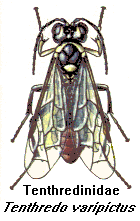 Hymenoptera: Leaf miners in this order are nearly all in the family Tenthredinidae or
sawflies. Most are free external feeders, but 15 North American species mine leaves.
These fall in 5 subfamilies: Phylltominae, Holocampinae, Dineurinae, Scolioneurinae,
and Schizocerinae. The Tenthredinidae, common sawflies, is a large group with about
nine out of 10 sawflies usually seen. Adults are wasplike, often brightly colored, on
leaves or flowers, medium sized to small of 20 mm or shorter. Some species are gall
formers (Euura on willow). The birch leaf miner, Fenusa pusilla, makes
blotch mines and can be a serious pest. In eastern USA this species has 2-3
generations a year and pupates in the ground. The elm leaf miner, Fenusa ulmi
also can be damaging. The two sexes are often differently colored. The leaf-mining
species have reduced legs and all make blotch mines.
Hymenoptera: Leaf miners in this order are nearly all in the family Tenthredinidae or
sawflies. Most are free external feeders, but 15 North American species mine leaves.
These fall in 5 subfamilies: Phylltominae, Holocampinae, Dineurinae, Scolioneurinae,
and Schizocerinae. The Tenthredinidae, common sawflies, is a large group with about
nine out of 10 sawflies usually seen. Adults are wasplike, often brightly colored, on
leaves or flowers, medium sized to small of 20 mm or shorter. Some species are gall
formers (Euura on willow). The birch leaf miner, Fenusa pusilla, makes
blotch mines and can be a serious pest. In eastern USA this species has 2-3
generations a year and pupates in the ground. The elm leaf miner, Fenusa ulmi
also can be damaging. The two sexes are often differently colored. The leaf-mining
species have reduced legs and all make blotch mines.
Lepidoptera: The moth and butterfly order has about 400 species in about 20 families
that mine leaves. The majority of the species occur in the families Nepticulidae,
Tischeriidae, Gracilariidae, and Gelechiidae.
Nepticulidae: minute moths, some only with wingspread of 3 mm, wing venation
reduced, surface of wings have spine-like hairs, most species make linear leaf mines
and pupate in soil, some Ectoedemia are gall makers.
Tischeriidae: small moths, hind wings are long and narrow, small or absent maxillary
palps, make blotch mines in oak, apple, blackberry and raspberry. Apple leaf trumpet
miner Tischeria malifoliella is common in eastern USA, they make trumpet
shaped mine in upper surface of leaf.
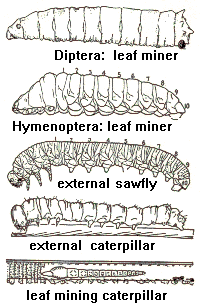 Gracilariidae: Leaf blotch miners, a large group of small to minute moths with pointed
wings, often fold leaves. The white oak leaf miner Lithocolletis hamadryadella
is common in eastern USA and feeds on oaks. Many mines, one larva to a mine, may
occur on a leaf. Larvae are flattened with rudimentary legs and prothoracic segment
enlarged laterally, pupate in mine. Phyllocnistis (linear mine) make linear
winding mines in poplar and aspen leaves.
Gracilariidae: Leaf blotch miners, a large group of small to minute moths with pointed
wings, often fold leaves. The white oak leaf miner Lithocolletis hamadryadella
is common in eastern USA and feeds on oaks. Many mines, one larva to a mine, may
occur on a leaf. Larvae are flattened with rudimentary legs and prothoracic segment
enlarged laterally, pupate in mine. Phyllocnistis (linear mine) make linear
winding mines in poplar and aspen leaves.
Gelechiidae: Very large family, small moths, some leaf miners, others gall makers
(Gnorimoschema) or leaf rollers, or feed on grain. An example if Angoumois
grain moth, Sitotroga cerealella. The pink bollworm, Pictinophora
gossypiella, is a serious pest of cotton feeding in the bolls (this moth has a fringed
wings). Phthorimaea operculella, the potato tuberworm is a pest of potatoes;
the larvae mine the leaves and bore into the tubers.
Ecology
The eggs of leaf mining insects are laid on the leaf surface, whereupon the larvae
must cut into the leaf, or the adult female cuts holes in the leaf and deposits eggs.
The larvae may spend their entire existence in the leaf or feed for only a few instars
there. Some mine the first few instars and then feed externally when larger. The head
is often wedge shaped to separate the epidermal layers, legs are small and reduced
as well as the antennae and eyes. Many are sap-feeding and merely damage the
tissues to then feed on the wound reactions. The food consists of palisade cells, the
parenchyma, and the oozing sap. Veins sometimes impede the miners so that they
must dwell in a confined area. If latex cells are cut in some plants, the secretions may
drown or kill the larvae. Some larvae are adept at avoiding such latex cells. Resinous
cells have toxic chemicals that deter non-host insects but have little affect on adapted
leaf miners. Each species makes a characteristic mine and can be identified by the
plant species and the "signature" of the mine and its location in the leaf. For example,
leaf miners attack poison ivy and other poisonous plants. The removal of frass
(feeding particles and fecal pellets) is a problem for leaf miners. The frass may be laid
down or packed in the mine, it may be pushed from the mine by "mine shafts" or holes
or the leaf miner leaves for a new leaf due to lack of room.
The majority of leaf mines are made during the middle or end of summer. Usually if
the attack is early in the spring then this leads to a gall. This is because when
meristematic tissue is attacked, the cells proliferate (hyperplasia) or enlarge
(hypertrophy) and form galls. Leaf mines occur usually in mature leaves. When they
need to pupate, they either do this in the mine or some distance away probably to
escape predation. Many also use frass and spine cocoons to protect themselves from
predation.
Leaf mining can have economic importance when succulent leaves, such as parsley
and delphinium, wilt as a result of the mining. The leaves of woody plants usually
remain turgid and functional in spite of the damage. The leaves of vegetables, fruit,
or ornamental plants are often damaged the most severely by mining. Spinach and
beet are mined by Pegomyia hyoscyami. In the past, chemical sprays have
been rather ineffective against leaf miners due to their protection within the plant.
Sources of Information
1. Borror, D.J. and DeLong, D.M. 1964. An Introduction to the Study of Insects. Holt,
Rinehart and Winston.
2. Borror, D.J. and White, R.E. 1970. A Field Guide to Insects. Houghton Mifflin Co.,
Boston.
3. Craighead, F.C. 1950. Insect Enemies of Eastern Forests. U.S.D.A. Misc. Pub. No.
657.
4. Frost, S.W. 1959. Insect Life and Insect Natural History. Dover Publications Inc., New
York.
5. Smith, R.C., Kelly, E.G., Dean, G.A., Bryson, H.R., and Parker, R.L. 1962. Insects in
Kansas. Extension Division, Kansas State Univ., Manhattan, Kansas.

and © by John A. Byers John.Byers@vsv.slu.se
 Leaf miners form a natural rather than a taxonomic group of insect species that are
adapted to a special type of environment.
Leaf miners form a natural rather than a taxonomic group of insect species that are
adapted to a special type of environment. The family Cecidomyiidae in the order Diptera (flies) have many species that
intergrade between gall making and leaf mining. The tulip spot gall, Thecodipolosis
liriodendri, is only a slight thickening of the leaf while the tar-spot gall, produced
by a species in the genus Asteriomyia has even less thickening is little more
than a leaf mine. The boxwood leaf miner, Monarthropalpus buxi, makes a leaf
mine but the surrounding tissues proliferate. None of the Cecidomyiidae, however,
produce long leaf mines typical of the Agromyzidae flies.
The family Cecidomyiidae in the order Diptera (flies) have many species that
intergrade between gall making and leaf mining. The tulip spot gall, Thecodipolosis
liriodendri, is only a slight thickening of the leaf while the tar-spot gall, produced
by a species in the genus Asteriomyia has even less thickening is little more
than a leaf mine. The boxwood leaf miner, Monarthropalpus buxi, makes a leaf
mine but the surrounding tissues proliferate. None of the Cecidomyiidae, however,
produce long leaf mines typical of the Agromyzidae flies. words in orders with complete metamorphosis and the highest degree of
specialization. The adults are able to fly and to select the appropriate host plant for
their larvae. Only the larvae are able to live in the interior of leaves since the adults
are winged and therefore disperse, find host plants, and mate. Most leaf-miner adults
are small and can be very beautifully colored.
words in orders with complete metamorphosis and the highest degree of
specialization. The adults are able to fly and to select the appropriate host plant for
their larvae. Only the larvae are able to live in the interior of leaves since the adults
are winged and therefore disperse, find host plants, and mate. Most leaf-miner adults
are small and can be very beautifully colored. The Buprestidae are the metallic wood-boring beetles (or flat-headed borers): most
larvae bore under bark or in wood. Adults are metallic copper, green, blue, or black
with hard bodies and can move rapidly with good eyes. The genus Brachys
have species that mine leaves of oak, and these species when disturbed draw up their
legs and "play dead" usually falling to the ground to avoid predation. Other leaf-mining
genera are Trachys and Pachyschelus. These beetles often visit flowers
as adults. The mines of Buprestidae are usually of the blotch type (a cave or irregular
area) but some make wide linear mines. Most mine the leaves of trees and
shrubs, while Taphrocerus mines leaves of sedges and a few species colonize
Leguminosae. Pieces of the leaf may be cut and stuck together with silk. Some
species are quite small, being only a mm or two. Wood boring buprestids can be large
in the tropics such as Euchroma goliath which is 6 cm long (2.5 inches)!
The Buprestidae are the metallic wood-boring beetles (or flat-headed borers): most
larvae bore under bark or in wood. Adults are metallic copper, green, blue, or black
with hard bodies and can move rapidly with good eyes. The genus Brachys
have species that mine leaves of oak, and these species when disturbed draw up their
legs and "play dead" usually falling to the ground to avoid predation. Other leaf-mining
genera are Trachys and Pachyschelus. These beetles often visit flowers
as adults. The mines of Buprestidae are usually of the blotch type (a cave or irregular
area) but some make wide linear mines. Most mine the leaves of trees and
shrubs, while Taphrocerus mines leaves of sedges and a few species colonize
Leguminosae. Pieces of the leaf may be cut and stuck together with silk. Some
species are quite small, being only a mm or two. Wood boring buprestids can be large
in the tropics such as Euchroma goliath which is 6 cm long (2.5 inches)! The Chrysomelidae (leaf beetles) is one of the largest families of beetles and includes
the Colorado Potato beetle. These beetles are relatively small (about 1 cm or less)
and often brightly colored. There are many serious pests in this family, and depending
on the species, the larvae feed externally on leaves or roots, bore into the plant, or are
leaf miners. The subfamily Hispinae are leaf-miners, e.g. Xenochalepus dorsalis
on black locust. The genera Chalepus, Microrhopala, Stenispa,
Anoplitis, Baliosis, and Uroplata are also leaf-miners in Hispinae
that are called wedge-shaped beetles. The elytra (wing covers) often are spiny or may
be ridged and sculptured. The larvae are flattened, short legs, and closely resemble
the Chrysomelidae. Another subfamily, Halticinae, has Dibolia borealis which
makes long winding mines on the broad-leaved plantain which may wither the plant.
Hippuriphila modeeri makes blotch mines on leaves of Rumex.
The Chrysomelidae (leaf beetles) is one of the largest families of beetles and includes
the Colorado Potato beetle. These beetles are relatively small (about 1 cm or less)
and often brightly colored. There are many serious pests in this family, and depending
on the species, the larvae feed externally on leaves or roots, bore into the plant, or are
leaf miners. The subfamily Hispinae are leaf-miners, e.g. Xenochalepus dorsalis
on black locust. The genera Chalepus, Microrhopala, Stenispa,
Anoplitis, Baliosis, and Uroplata are also leaf-miners in Hispinae
that are called wedge-shaped beetles. The elytra (wing covers) often are spiny or may
be ridged and sculptured. The larvae are flattened, short legs, and closely resemble
the Chrysomelidae. Another subfamily, Halticinae, has Dibolia borealis which
makes long winding mines on the broad-leaved plantain which may wither the plant.
Hippuriphila modeeri makes blotch mines on leaves of Rumex.
 The Curculionidae (weevils or snout beetles) are another large family of beetles with
over 3100 species in North America (and some taxonomists break this family into 11
families). The species have many diverse feeding habits from external feeding to
boring in any plant part, a few even cause galls (Podapion gallicola). The
mandibular mouth parts are small and at the end of a "snout" or "beak" on their head.
Most weevils when disturbed draw their legs and antennae to the body and fall to the
ground. While some are brightly colored, most are cryptic and hard to find. Many can
produce noises by stridulation (rubbing various body parts together to produce sound -
often heard only weakly near the human ear). Another genus is Orchestes,
predominately in Europe, that mine leaves of oaks, alders, and willows. The apple flea
weevil, Orchestes pallicornis may damage fruit in the eastern USA as well as
leaves of elm, willow, shadbush, alder, cherry, and apple. Prionomerus
calceatus mines sassafras and tulip tree leaves. Adults may also feed on the
leaves, making small holes much as do flea beetle adults.
The Curculionidae (weevils or snout beetles) are another large family of beetles with
over 3100 species in North America (and some taxonomists break this family into 11
families). The species have many diverse feeding habits from external feeding to
boring in any plant part, a few even cause galls (Podapion gallicola). The
mandibular mouth parts are small and at the end of a "snout" or "beak" on their head.
Most weevils when disturbed draw their legs and antennae to the body and fall to the
ground. While some are brightly colored, most are cryptic and hard to find. Many can
produce noises by stridulation (rubbing various body parts together to produce sound -
often heard only weakly near the human ear). Another genus is Orchestes,
predominately in Europe, that mine leaves of oaks, alders, and willows. The apple flea
weevil, Orchestes pallicornis may damage fruit in the eastern USA as well as
leaves of elm, willow, shadbush, alder, cherry, and apple. Prionomerus
calceatus mines sassafras and tulip tree leaves. Adults may also feed on the
leaves, making small holes much as do flea beetle adults.  A few species of Tipulidae and Trupaneidae, considerably more Cecidomyiidae (gall makers)
also mine leaves. The Agromyzidae make linear mines, e.g. Phytomyza obscurella
nigritella on peach and Agromyza on nasturtium. A. coronata and
A. posticata produce blotch mines on goldenrod. A linear mine that turns into
a blotch is made by A. aristata on elm and A. borealis on jewel
weed.
A few species of Tipulidae and Trupaneidae, considerably more Cecidomyiidae (gall makers)
also mine leaves. The Agromyzidae make linear mines, e.g. Phytomyza obscurella
nigritella on peach and Agromyza on nasturtium. A. coronata and
A. posticata produce blotch mines on goldenrod. A linear mine that turns into
a blotch is made by A. aristata on elm and A. borealis on jewel
weed. Hymenoptera: Leaf miners in this order are nearly all in the family Tenthredinidae or
sawflies. Most are free external feeders, but 15 North American species mine leaves.
These fall in 5 subfamilies: Phylltominae, Holocampinae, Dineurinae, Scolioneurinae,
and Schizocerinae. The Tenthredinidae, common sawflies, is a large group with about
nine out of 10 sawflies usually seen. Adults are wasplike, often brightly colored, on
leaves or flowers, medium sized to small of 20 mm or shorter. Some species are gall
formers (Euura on willow). The birch leaf miner, Fenusa pusilla, makes
blotch mines and can be a serious pest. In eastern USA this species has 2-3
generations a year and pupates in the ground. The elm leaf miner, Fenusa ulmi
also can be damaging. The two sexes are often differently colored. The leaf-mining
species have reduced legs and all make blotch mines.
Hymenoptera: Leaf miners in this order are nearly all in the family Tenthredinidae or
sawflies. Most are free external feeders, but 15 North American species mine leaves.
These fall in 5 subfamilies: Phylltominae, Holocampinae, Dineurinae, Scolioneurinae,
and Schizocerinae. The Tenthredinidae, common sawflies, is a large group with about
nine out of 10 sawflies usually seen. Adults are wasplike, often brightly colored, on
leaves or flowers, medium sized to small of 20 mm or shorter. Some species are gall
formers (Euura on willow). The birch leaf miner, Fenusa pusilla, makes
blotch mines and can be a serious pest. In eastern USA this species has 2-3
generations a year and pupates in the ground. The elm leaf miner, Fenusa ulmi
also can be damaging. The two sexes are often differently colored. The leaf-mining
species have reduced legs and all make blotch mines. Gracilariidae: Leaf blotch miners, a large group of small to minute moths with pointed
wings, often fold leaves. The white oak leaf miner Lithocolletis hamadryadella
is common in eastern USA and feeds on oaks. Many mines, one larva to a mine, may
occur on a leaf. Larvae are flattened with rudimentary legs and prothoracic segment
enlarged laterally, pupate in mine. Phyllocnistis (linear mine) make linear
winding mines in poplar and aspen leaves.
Gracilariidae: Leaf blotch miners, a large group of small to minute moths with pointed
wings, often fold leaves. The white oak leaf miner Lithocolletis hamadryadella
is common in eastern USA and feeds on oaks. Many mines, one larva to a mine, may
occur on a leaf. Larvae are flattened with rudimentary legs and prothoracic segment
enlarged laterally, pupate in mine. Phyllocnistis (linear mine) make linear
winding mines in poplar and aspen leaves.